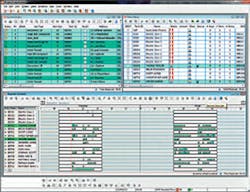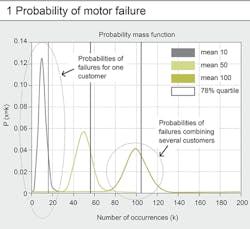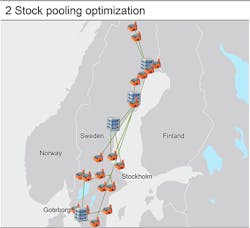A new software being developed by ABB can improve maintenance scheduling in industrial plants.
Workforce scheduling
Sleman Saliba, Michael Hamilton, Carsten Franke - Service organizations in the utility and communications industries operate in an everchanging environment of rising costs, complex regulations, mergers and acquisitions, and customers' high expectations of reliability, responsiveness and quality service. To meet these challenges, it is critical that utilities optimize service delivery, make efficient use of field technicians and equipment, and improve the reliability of critical assets.
With over 100,000 technicians using the system every day, Service Suite is the enterprise workforce management (EWFM) solution that provides a complete platform to efficiently plan, schedule and execute all types of field work ➔ 1. Service Suite's performance-enhancing optimizer assigns the right orders to the right technicians, based on skill and availability, and then routes them optimally between assignments to minimize travel time. This enables customers to realize significant increases in field productivity, decreased labor costs, reduced travel time and vehicle expenses, increased technician autonomy and accountability, and improved data quality.
Mathematical optimization
ABB's research centers are working with Ventyx, an ABB company, to improve the current scheduling algorithms. The goal is to introduce new scheduling algorithms to address the increasingly complex customer requirements in the field.
By watching the newest advances in mathematical scheduling optimization, the research team can include methods from integer programming, graph theory or online optimization into Service Suite. The most suitable techniques are then chosen to be implemented in the next generation workforce management solution.
A common problem in workforce management is the allocation of skilled technicians to customer orders and the routing of technicians. The research team is developing a column generation approach with labeling to construct a near optimal schedule. Column generation with labeling proves to be the most effective method to solving complex routing problems, as explained, eg, in [1].
By using the labeling algorithm, an extensively large set of feasible routes for each service technician can be constructed. The resulting routes contain as many customer orders as possible with a suitable skill match. The algorithm ensures that time windows for orders are fulfilled. Additionally, each route is required to comply with the legal regulations of mandatory breaks during the day and allowed overtime. For each feasible route, the labeling algorithm calculates the value of an objective function. This value represents the quality of the matching between orders and technicians, as well as the travel times between subsequent orders in the route. Having the sets of feasible routes and their objective function value, column generation is then applied to pick the best set of routes such that each service technician serves exactly one route, each customer order is in at most one route and the objective value of the overall schedule is maximized.
This approach maximizes customer satisfaction while lowering the overall cost of service delivery and assurance, and ensures the allocation of appropriately skilled workers to each order.
Routing techniques
Another challenge is to include advanced street-level routing technologies during the optimization. This goes beyond the usage of simple navigation systems for traveling from one order to another. The accuracy of time estimations can be increased by using street-level routing technologies during the optimization of the driving routes, rather than as a post-optimization step. Therefore, the precision in the different application scenarios all around the world can be increased. Improved planning solutions are completed by fast algorithms that respond to real-time changes happening during the day, such as new urgent work, cancelled orders, or orders that technicians finish early.
The column-generation-based approach is computationally intensive, requiring a lot of computer time to optimize a schedule. However, during a working day, utilities and communication companies need to readjust the scheduling result in order to reflect real-life changes. That is, a new task might have been added, some technicians might be unavailable due to sickness, etc.
Therefore, Service Suite must be able to readjust the solution on demand. The computation time reflecting the changes is limited to a few minutes such that the operating company can use the new solution and communicate it to the corresponding technicians in the field.
Several heuristics based on local search techniques are used to select only the most suitable subsets of orders and technicians for a new mathematical optimization run by applying the existing column generation approach. These heuristics are developed in order to react quickly and accurately to the described changes.
The heuristics take the street-evelbased traveling times between orders and the already-planned orders into consideration. Furthermore, customers can choose between different heuristics to trade-off between the required solution time for the readjustment and the quality of the resulting schedule.
By drawing on expertise in different areas of the company, ABB ensures the continuation of the leading edge in the newest technologies and upcoming challenges in the service industry.
Sleman Saliba
ABB Corporate Research
Ladenburg, Germany
[email protected]
Michael Hamilton
Ventyx, an ABB company
Richmond, Canada
[email protected]
Carsten Franke
ABB Corporate Research
Baden-Dattwil, Switzerland
[email protected]
Reference
[1] Desaulniers, G., Desrosiers, J., Solomon, M.M. (2005) Column generation.
-----------------------------------------------
Reliability feedback system
Ralf Gitzel, Moritz Hochlehnert, Simone Turrin - ABB's reliability feedback system project is developing tools for generator circuit breakers that can help to facilitate the paradigm shift from traditional time-based monitoring to condition-based maintenance strategies.
In many working environments there are different kinds of safety-related equipment available to prevent or mitigate situations where human life is endangered. Naturally, such equipment has to be carefully and regularly maintained. However, in many cases this results in expensive scheduled downtime. Finding the right amount of maintenance to save costs without compromising safety is not always easy.
As ABB strives to extend its core generator circuit breaker (GCB) products with increasingly complex life-cycle services, the need for appropriate tools and concepts facilitating transparency on the residual lifetime and the generated value for the customer is becoming clear.
As a result, the reliability feedback system (RFS) project has emerged. The pilot's goal was to obtain reliability data such as residual life from the field in order to help ABB service personnel recommend the right overhaul intervals for GCB to power plant owners with the RFS-GCB software prototype.
Typical life spans are 20 to 40 years. Failures can cause critical situations in a power plant and therefore regular inspections and overhauls are important.
The residual life of a GCB is the amount of ablation the breaker can take before an overhaul is required. The breaker has three types of residual life; the overhaul occurs when the first reaches zero.
Electrical residual life
Each time a circuit breaker operates, its contacts get ablated and eventually are no longer functional due to cumulative ablation. The amount of ablation suffered depends on the interrupted current and has to be traced for each contact separately. (Typically, there are three phases and therefore three electrical residual life curves.) Thus, each switching operation results in a reduction of residual life, with different amounts of ablation.
Mechanical residual life
The mechanical residual life is reduced by one every time the circuit breaker is triggered. Mechanical residual life represents mechanical wear out of the system. Unlike in the electrical case, there is only one curve for mechanical residual life.
Time-based residual life
If neither the mechanical nor the electrical residual life is used up within a certain time limit, an overhaul is nevertheless conducted to account for other problems not modeled in the other residual life concepts.
Using residual life in maintenance
ABB service personnel use a myriad of information to determine the right time for the overhaul of a GCB. Long-time experience, measurements and service reports are an important part of the decision-making process. The newly developed RFS-GCB software helps the process by using residual life information to suggest possible overhaul dates. While these dates are subject to change with every extraordinary switching event, the scheduled dates are a good basis for long-term overhaul planning. Internally, a mathematical extrapolation algorithm is used to anticipate the expected future development of the residual life based on its development in the past. At the point in time where the first of the extrapolated residual life curves (ie, mechanical, electrical and time) reaches zero, an overhaul is scheduled. Naturally, the extrapolation includes a reasonable safety margin, so a residual life of zero does not mean that the GCB is no longer functional.
An overhaul plan based on residual life values can easily be created on a calendar with each kind of residual life represented by an entry marked with a tick. A calendar can be created for an individual breaker or for a whole fleet. Based on the entries, a maintenance technician can create individual maintenance plans, which make use of synergies to minimize downtime.
With GCB there are two different maintenance jobs - overhauls and inspection. An overhaul occurs when either one of the three electrical contacts' residual life reaches zero, the mechanical life reaches zero or the time limit is reached. When half of the time-based residual life is used up, an inspection should be performed. This date can also be indicated in a calendar.
Dates for overhauls/inspections can change over time. This may be caused by extraordinary, unexpected events in the GCB history. To avoid confusion, any entries on a calendar that have been moved are marked with a red cross in their old location. This way, it is always possible to keep track of the changes made to the schedule.
It should be noted that such a suggested schedule is only one input on which the service technician can base his recommendation to the customer. The RFS-GCB software also includes textual information on past service events and other data, which helps assess the health of the GCB. This information, together with experience and other data from the site, allows the service technician to give the customer a well-founded maintenance recommendation.
With RFS the service business would be in a position to periodically review the condition of the GCB to define and recommend service activities like inspection and electrical overhaul in a proactive manner. While RFS-GCB is still in the testing phase, it offers great potential for ABB's power plant customers to reduce their maintenance downtime while still ensuring proper operation of their GCBs. Combined with the knowledge and expertise of seasoned service technicians, RFS-GCB will provide customers with optimized schedules not only for individual breakers but also for their breaker fleet.
Ralf Gitzel
Simone Turrin
ABB Corporate Research Center
Ladenburg, Germany
[email protected]
[email protected]
Moritz Hochlehnert
ABB Power Products, High Voltage Products
Zurich, Switzerland
[email protected]
-----------------------------------------------
Stock pooling optimization
Ralf Gitzel, Iiro Harjunkoski, Cajetan T. Pinto - In many industries, motors form a crucial part of the production equipment. Due to the myriad of sizes and specifications, many customers end up having a broad collection of various motors in their plant, some of which are critical for production. The consequence of this variety is that the customer needs a large number of spare motors to cover against potential failures. Especially in older facilities, where many motors are way beyond their intended life span, special care must be taken to at least cover the mission-critical equipment.
Investing in spare motors means nonproductive spending and results in bound capital. On the other hand, too few spare motors pose a significant risk to the operability of the plant. ABB's stock pooling optimization project is currently working on a solution that can lower customers' costs without increasing the risk of downtime.
The room for cost-effective improvement in this regard, realizable by an individual customer, is limited - either the spare motors are available or not. ABB, on the other hand, is in a unique position as a motor provider to help its customers by offering a spare motor service.
The gray curve shows the spare motor demand of a single customer for a single motor type in one year. The green curve shows the same demand for a fleet of 10 identical customers.
Pooling effect
There is a distinctive difference between planning for a small amount of motors and for a larger fleet. For example, a single customer has a roughly 25 percent chance of needing more than 12 spare motors of a particular type in a year. However, the chance that 10 customers will need more than 120 motors is far below 25 percent, as indicated by the quartile. Colloquially speaking, the flatter and wider green curve is less prone to unexpected behavior than the gray curve multiplied by 10 ➔ 1. This implies that the required safety margin for the green curve is lower than the sum of all safety margins needed by single customers.
Unfortunately, with a distributed and diverse customer installed base, realizing the pooling effect requires careful consideration. Firstly, customer demand of spare motors is based on failure rates and will vary individually according to industry and plant health. This means that a careful prediction is required. Secondly, when spare motors are not stored on site, an optimized supply chain is needed to ensure that motors are available within a specified time.
A new project
The stock pooling optimization project addresses these two challenges. A multidisciplinary team of researchers working in cooperation with Carnegie Mellon University is currently developing an algorithm to reliably predict customer demand and to optimize the supply chain in order to meet this demand while realizing cost savings potential for the customers.
The current concept bases the demand forecasts for spare motors on the customer failure data. Using maintenance-related data, it is possible to calculate an annual failure rate and to make predictions using a homogeneous Poisson process (HPP). Two key parameters are determined by the prediction: The expected number of failures describing the average case, and a safety margin to avoid the risk of out-of-stock, which is calculated based on the probabilities provided by the HPP.
Customers are able to look at a screen shot that displays a possible solution to the supply network problem.
Problem solving
To address the problem of guaranteed and timely spare motor availability, an extensive optimization problem needs to be solved. Based on motor criticality specified in contracts, the motors must be delivered before their respective deadlines. To reach this goal, a sufficient amount of motors must be stored in the correct locations without overstocking. In other words, the algorithm has to determine the optimal network of factories, warehouses and the required stock levels at the warehouses. With the software prototype, customers are able to actually look at a screen shot that displays a possible solution to the supply network problem ➔ 2. In the context of the stock pooling optimization project, mixed-integer linear programming (MILP) will be used to find the optimal solution. The definition of the MILP model has to be done carefully; too many variables may result in an unsolvable problem due to the large size. On the other hand, if the problem model is too simple, the mathematically optimal solution may no longer reflect reality.
The stock pooling optimization algorithm is currently still under development and initial results show the great potential of a scientific approach to the problem. Trustworthy demand predictions based on established methods and supply chain optimization using state-of-the-art algorithms enable a cost-effective pooling concept and improved and more responsive spare-part service. For the customer, stock pooling means less capital bound in spare motors without an increased risk of downtime. Stock pooling could be of great benefit to a wide range of plant operators, eventually going beyond motors to include other kinds of spare parts.
Ralf Gitzel
Iiro Harjunkoski
ABB Corporate Research Center
Ladenburg, Germany
[email protected]
[email protected]
Cajetan T. Pinto
ABB Automation Products
Mumbai, India
[email protected]







